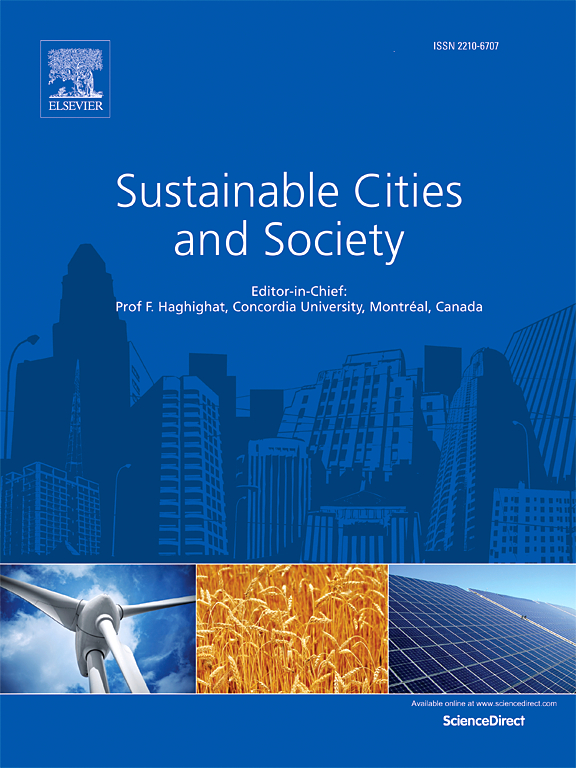Enhancing resilience of green-grey infrastructure by integrating two redundancy strategies into a multi-objective optimization and service period assessment framework
IF 10.5
1区 工程技术
Q1 CONSTRUCTION & BUILDING TECHNOLOGY
引用次数: 0
Abstract
Green-grey infrastructure is increasingly recognized for its role in mitigating flood risks and promoting sustainable stormwater management. Despite extensive research on optimization, enhancing system resilience through improved drainage network redundancy remains under-explored. This study aims to address this gap by integrating two redundancy strategies, i.e., parallel pipelines and redundant paths, into a multi-objective optimization framework to enhance the system resilience from the cross-sectional and top-down dimensions, respectively. Iterative layouts were designed using a graph-theoretic algorithm coupled with green infrastructure optimization. The predominant objectives were to reduce life cycle costs and enhance resilience against urban flood pressures caused by extreme storms and infrastructure failures. A service period assessment method was employed to evaluate the sustainability gains for the optimized layouts provided by redundancy strategies. The findings indicated that both parallel pipeline and redundant path strategies significantly improve sustainability, with pronounced effectiveness in decentralized and centralized layouts, respectively. Additionally, these strategies were more effective in addressing internal pressure of infrastructure failures than external pressure of extreme storm. Consequently, three decentralized green-grey infrastructure layouts incorporating both redundancy strategies are recommended for decision-makers. This framework offers novel insights into the application of redundancy strategies for the design and planning of sustainable urban drainage systems.
通过将两种冗余策略集成到多目标优化和服务周期评估框架中,增强绿灰基础设施的弹性
绿灰基础设施在减轻洪水风险和促进可持续雨水管理方面的作用日益得到认可。尽管对优化进行了广泛的研究,但通过改善排水网络冗余来增强系统弹性的探索仍然不足。本研究旨在通过将并行管道和冗余路径两种冗余策略整合到一个多目标优化框架中,分别从横截面和自顶向下两个维度增强系统的弹性,从而解决这一差距。采用图论算法结合绿色基础设施优化设计迭代布局。主要目标是降低生命周期成本,增强抵御极端风暴和基础设施故障造成的城市洪水压力的能力。采用服务期评价方法对冗余策略优化布局的可持续性收益进行评价。研究结果表明,平行管道和冗余路径策略都能显著提高可持续性,在分散布局和集中布局中分别具有显著的有效性。此外,这些策略在解决基础设施故障的内部压力方面比极端风暴的外部压力更有效。因此,建议决策者采用三种分散的绿灰基础设施布局,同时采用两种冗余策略。该框架为可持续城市排水系统设计和规划中冗余策略的应用提供了新颖的见解。
本文章由计算机程序翻译,如有差异,请以英文原文为准。
求助全文
约1分钟内获得全文
求助全文
来源期刊

Sustainable Cities and Society
Social Sciences-Geography, Planning and Development
CiteScore
22.00
自引率
13.70%
发文量
810
审稿时长
27 days
期刊介绍:
Sustainable Cities and Society (SCS) is an international journal that focuses on fundamental and applied research to promote environmentally sustainable and socially resilient cities. The journal welcomes cross-cutting, multi-disciplinary research in various areas, including:
1. Smart cities and resilient environments;
2. Alternative/clean energy sources, energy distribution, distributed energy generation, and energy demand reduction/management;
3. Monitoring and improving air quality in built environment and cities (e.g., healthy built environment and air quality management);
4. Energy efficient, low/zero carbon, and green buildings/communities;
5. Climate change mitigation and adaptation in urban environments;
6. Green infrastructure and BMPs;
7. Environmental Footprint accounting and management;
8. Urban agriculture and forestry;
9. ICT, smart grid and intelligent infrastructure;
10. Urban design/planning, regulations, legislation, certification, economics, and policy;
11. Social aspects, impacts and resiliency of cities;
12. Behavior monitoring, analysis and change within urban communities;
13. Health monitoring and improvement;
14. Nexus issues related to sustainable cities and societies;
15. Smart city governance;
16. Decision Support Systems for trade-off and uncertainty analysis for improved management of cities and society;
17. Big data, machine learning, and artificial intelligence applications and case studies;
18. Critical infrastructure protection, including security, privacy, forensics, and reliability issues of cyber-physical systems.
19. Water footprint reduction and urban water distribution, harvesting, treatment, reuse and management;
20. Waste reduction and recycling;
21. Wastewater collection, treatment and recycling;
22. Smart, clean and healthy transportation systems and infrastructure;
 求助内容:
求助内容: 应助结果提醒方式:
应助结果提醒方式:


